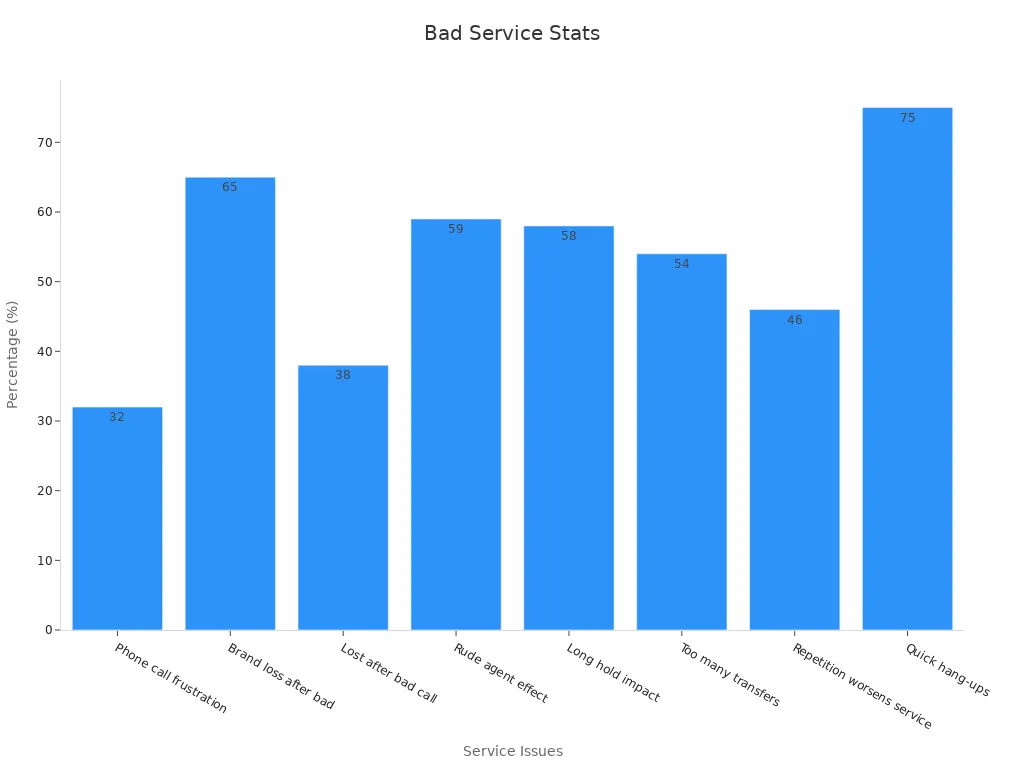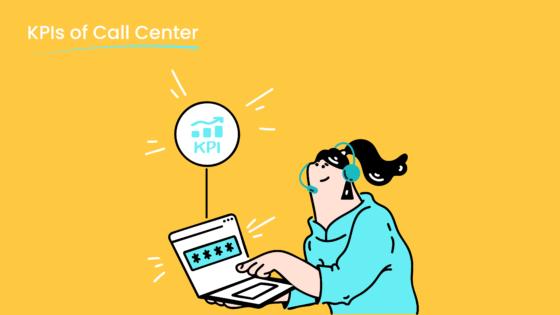Shocking Bad Customer Service Examples in Retail Stores

Ever left a retail store fuming after a rude cashier or endless wait? You’re not alone. Over 65% of shoppers walk away from brands after just one bad customer service experience, and 59% say rude staff ruin their day. Maybe you’ve shared your own bad customer service stories with friends or even posted a review. Check out this chart—bad customer service examples in retail spread fast and hit hard:

Retailers can fix these issues with smart tools like Sobot AI, making every customer service moment count.
What Is Bad Customer Service?
Common Signs in Retail
You know bad customer service when you see it. Maybe you walk into a store and no one greets you. Sometimes, you ask for help and the staff ignores you or gives you short answers. Other times, you wait forever at the checkout or for someone to answer your questions. These are all signs that something is wrong with the retail experience.
Retailers use different ways to measure how well they serve you. They look at things like Customer Satisfaction Score (CSAT) and Net Promoter Score (NPS). These scores come from surveys you fill out after shopping. Stores also check how much effort you put in to get help, called Customer Effort Score (CES). If you see lots of product returns or complaints, that’s another red flag. Fewer returning customers or a drop in foot traffic can mean people are unhappy with the service. Even mystery shoppers visit stores to see if the staff treats customers well.
Tip: If you want to avoid these problems, look for stores that use smart tools like Sobot. Sobot helps retail teams track customer feedback, manage calls, and respond faster, so you get better service every time.
Impact on Customer Experience
Bad customer service does more than just ruin your day. It can cost businesses a lot of money and drive customers away. Did you know that bad customer experiences are expected to cost companies $3.7 trillion in 2024? That’s a huge jump from last year. Over 64% of shoppers say they would switch to another store after just one bad experience, even if they like the products. Only 15% of people forgive a brand after a really poor customer service experience.
Here are some quick facts about the impact of bad customer service in retail:
- 80% of shoppers have had poor customer service.
- 67% share their bad experience with others.
- 53% stop spending after just one bad experience.
- 60% say they would buy more if treated better.
When you get great customer service, you feel valued and want to come back. But when the service is bad, you might leave a bad review or never return. That’s why many retailers now use solutions like Sobot’s omnichannel platform. It helps them respond quickly, listen to feedback, and make sure every customer experience is a good one.
Bad Customer Service Examples in Retail

Poor Communication
You walk into a store and ask a question, but the staff gives you a confusing answer or none at all. That’s one of the most common bad customer service examples in retail. Poor communication can turn a simple shopping trip into a customer service nightmare. Here are some ways this happens:
- Stores send out mass messages that don’t matter to you or the staff. People start ignoring these updates.
- Managers pass down information, but it gets lost or changed. You end up getting the wrong details.
- Employees have to leave the sales floor to check messages, so you wait longer for help.
- A recent survey found that 36% of retail workers feel disconnected from their company. That’s a big gap.
- Only 23% of company leaders think their teams understand the company’s goals.
One famous case happened at Starbucks in 2018. A manager called the police on two men waiting to order. This mistake came from poor communication and training. The story went viral, and Starbucks had to close thousands of stores for special training. You can see how a single communication fail can cause a huge nightmare for both customers and brands.
If you want to avoid these customer experience fails, look for stores that use smart tools. Sobot’s omnichannel platform helps retail teams keep everyone in the loop. It connects calls, chats, and messages in one place, so you get clear answers fast.
Note: When stores use better communication tools, you get better service and fewer headaches.
Rude or Uncaring Staff
Nothing ruins your day faster than rude or uncaring staff. You ask for help, but the employee rolls their eyes or ignores you. These bad customer service examples in retail drive away shoppers and hurt the store’s reputation. Here’s what happens when staff don’t care:
- Lost revenue and fewer sales because customers leave and never come back.
- Angry customers tell their friends and post online, spreading the frustration.
- The store’s reputation takes a hit, especially if the story goes viral.
- Stores spend more money trying to win back lost customers.
- Employees feel stressed and quit, making the problem worse.
| Metric/Indicator | Description/Impact | Example/Source |
|---|---|---|
| Customer Churn Rate | Percentage of customers leaving due to poor service | 52% of consumers switched brands due to poor service (Accenture study) |
| Negative Reviews and Ratings | Bad reviews online damage reputation | Clothing store gets poor reviews for rude staff |
| Lost Revenue Opportunities | Missed sales from unresolved issues | Tech store loses sales when staff ignore customers |
| Decreased Repeat Business | Fewer returning customers after bad experiences | Home decor store loses loyal shoppers |
| Increased Customer Acquisition Costs | More money spent to replace lost customers | Higher marketing costs |
| Brand Reputation and Trust | Social media backlash erodes trust | Viral complaints hurt brand image |
| Employee Morale and Turnover | Unhappy staff leave, making service worse | High turnover in support teams |
You might have seen a customer service nightmare go viral on social media. One rude moment can lead to thousands of angry comments and a drop in sales. These terrible customer service moments show why kindness and empathy matter so much in retail.
Sobot helps stores train staff and track feedback. With Sobot’s tools, managers can spot problems early and fix them before they become a nightmare for everyone.
Long Wait Times
You stand in line, watching the clock. Minutes feel like hours. Long wait times are one of the worst customer experience fails in retail. They cause frustration and make you want to leave. Here’s what the numbers say:
- 90% of shoppers wait in line regularly, and retail stores have the longest waits.
- Since 2022, wait times in stores have gone up by 30%.
- 67% of people feel impatient, frustrated, or bored while waiting.
- 68.5% of retail workers say long waits are the top cause of customer frustration.
- 58% of customers stop shopping with a brand after just one bad experience, often because of long waits.
- Self-service kiosks and queue management systems can cut wait times by up to 30% and boost satisfaction by 25%.
A study found that if stores could get rid of long response times, they could increase revenue by nearly 15%. That’s a huge difference. Long waits don’t just annoy you—they cost stores money and loyal customers.
Tip: Stores using Sobot’s Voice/Call Center can manage calls and messages faster. This means you spend less time waiting and more time shopping.
Bad customer service examples in retail often start with poor communication, rude staff, or long waits. These customer service examples show why it’s so important for stores to focus on you and your needs. When stores use smart solutions like Sobot, you get better service and fewer customer service nightmares.
Poor Customer Service: Causes and Consequences
Rigid Policies
Have you ever tried to return something at a retail store and felt like you had to jump through hoops? Rigid policies can turn a simple return into a nightmare. Many stores stick to strict rules for returns, exchanges, or billing. This makes you feel frustrated and ignored. Here’s what often happens:
- Complicated return rules confuse you and make you give up.
- Staff say, “Sorry, that’s our policy,” instead of helping.
- You leave the store with a complaint and never want to come back.
Strict rules like these cause bad customer service and lead to more customer complaints. When stores refuse to bend the rules, you lose trust and loyalty. Some brands, like Ritz-Carlton, let employees solve problems on the spot. This stops a customer service crisis before it starts. If stores used flexible tools, like Sobot’s omnichannel platform, staff could see your history and help you faster, making returns less of a nightmare.
Lack of Empathy
Nothing feels worse than when a retail worker doesn’t care about your problem. Lack of empathy is a huge reason for poor customer service. Studies show that 70% of buying experiences depend on how you feel treated. When staff listen and show they care, you feel valued. Zappos built its reputation on empathy, turning unhappy shoppers into loyal fans.
Empathy does more than just make you happy. Teams that focus on empathy see a 32% jump in demo conversions and a 27% boost in sales. Even better, 86% of people say they’ll pay more for a better customer experience. When you feel heard, you’re more likely to return and tell friends about the great service. Sobot helps retail teams track feedback and respond with care, so you never feel ignored.
Passing the Customer Around
You call a store for help. The first person says, “Let me transfer you.” Then you explain your problem again. And again. This is a classic sign of terrible customer service. Passing you from one person to another wastes your time and increases frustration.
This nightmare happens when staff don’t have the right tools or information. You get tired, angry, and might leave a bad review. Sobot’s Voice/Call Center gives agents a unified workspace, so they see your info right away. This means you get answers faster and don’t have to repeat yourself. Stores that use smart systems avoid this terrible customer service trap and keep you coming back.
Real-Life Bad Experience Stories

Viral Incidents
You might think your bad experience at a store is unique, but some bad customer service stories go viral and shock everyone. Here are a few wild examples:
- A woman once got a phone bill for £10 trillion and was told to pay it in three days. The company showed no empathy and just repeated their policy.
- Barbara ordered three cartons of toilet paper for about $90. She got charged over $7,000 in shipping fees. Amazon refused to refund her at first, saying the package arrived on time. Only after her story hit the news did Amazon fix it.
- One customer waited on hold for 15 hours, only to be told their request was denied because of an error. That’s one of those customer experience fails you never forget.
- A retail worker loudly announced a declined credit card, embarrassing the customer in front of everyone.
These bad customer service stories spread fast online. They lead to negative reviews and damage the store’s reputation. You can see how a single fail can turn into a disaster for any retail brand.
Famous Retail Fails
Retail fails don’t just happen to small stores. Even big brands face huge failures that make headlines. Domino’s Pizza had a viral crisis in 2009 when two employees posted videos of adulterated food. The videos got over a million views in just 24 hours. That’s a customer experience fail that hurt trust and led to thousands of negative reviews.
Retail theft is another area where failures pile up. In New York City, changes in prosecution policies led to more shoplifting and violence. Convictions for repeat offenders dropped from 94% in 2018 to 57% in 2023. These failures forced stores to close, which made theft stats look better but didn’t solve the real problem. The National Retail Federation found that external theft still causes about 36% of retail shrinkage every year.
When you see these bad customer service stories and failures, you know why so many people leave negative reviews and never return.
Michael Kors & Sobot Success
Not every story ends in failure. Michael Kors faced its own bad experience with slow responses and unhappy customers. They needed a way to fix these customer experience fails and avoid more negative reviews. That’s when they turned to Sobot.
With Sobot’s all-in-one platform, Michael Kors unified their customer channels and improved service. They cut response times by 83%, reached a 95% satisfaction rate, and boosted conversion rates by 20%. Sobot’s omnichannel tools let agents see all customer info in one place, so you never have to repeat yourself. Now, Michael Kors gets fewer negative reviews and more happy shoppers.
When you use smart solutions like Sobot, you can turn retail failures into customer service wins.
Improving Customer Service with Sobot

Voice/Call Center Solutions
If you want to fix bad customer service in retail, start with your call center. Sobot’s Voice/Call Center gives you smart tools to handle calls quickly and smoothly. You can route calls to the right agent, use AI-powered voicebots, and track every call in real time. This means you don’t have to repeat your problem or wait forever for help. Companies using Sobot have seen up to a 45% drop in escalation rates and a 30% boost in upsell performance. Customer satisfaction scores often jump by over 30% after switching to Sobot. You get proactive customer service because agents see your info right away and solve problems before they grow.
Omnichannel Support
Today, shoppers want help on their favorite channels—phone, chat, email, or even WhatsApp. Sobot’s omnichannel platform brings all these together. Your team can see every message and ticket in one place, so no one gets lost or ignored. This unified approach cuts response times in half and makes it easy to follow up after a return or answer questions fast. Sobot’s system connects with your CRM, so you always have the latest customer info. With proactive customer service, you can reach out before issues turn into complaints.
Tip: 93% of shoppers buy again from brands with great customer service. If you want loyal customers, make every interaction count.
Actionable Tips for Retailers
You can improve customer service in your store with a few simple steps:
- Train your staff to listen and show empathy.
- Use Sobot’s tools to track feedback and spot problems early.
- Offer easy ways for customers to contact you, especially after a return.
- Respond quickly on every channel—speed matters.
- Personalize your service. Remember names, past purchases, and preferences.
Studies show that improving customer retention by just 5% can boost profits by 25% (source). When you invest in proactive customer service and use smart solutions like Sobot, you build trust and keep shoppers coming back.
You’ve seen how poor customer service can damage a store’s reputation and drive shoppers away. When you focus on empathy, clear communication, and flexible policies, you build trust and loyalty. Sobot’s Voice/Call Center gives you tools to respond faster and boost satisfaction—retailers using AI solutions like Sobot see a 25% jump in customer satisfaction and a 35% productivity boost. Want better results? Share your own story or explore how Sobot can help you deliver standout service.
FAQ
What are the most common bad customer service examples in retail?
You often see rude staff, long wait times, and poor communication. A 2023 survey showed 67% of shoppers left stores after just one bad customer service example in retail. These issues hurt trust and make people share negative reviews.
How can I avoid bad customer service in retail stores?
Look for stores that use smart tools like Sobot. Stores with omnichannel support and fast response times usually care about your experience. You can also check online reviews for bad customer service examples in retail before you shop.
Why do bad customer service examples in retail go viral so quickly?
People love to share shocking stories. Social media spreads bad customer service examples in retail fast. One rude moment or long wait can reach thousands in hours. Brands lose trust and sales when these stories go public.
How does Sobot help retailers fix bad customer service examples in retail?
Sobot gives stores tools like Voice/Call Center and omnichannel support. Staff see your info right away and respond faster. Michael Kors used Sobot and cut response times by 83%. You get better service and fewer bad customer service examples in retail.
See Also
Enhancing Customer Engagement With Live Chat In Retail
Expert Strategies For Effective Live Chat In Retail
Step By Step Guide To Shopify Live Chat For Retail
